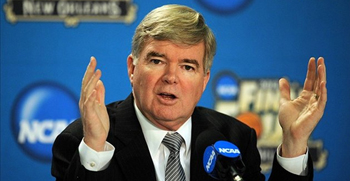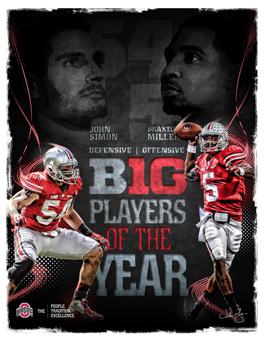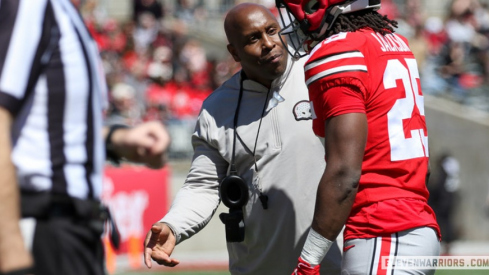In November 2010, when Mark Emmert became the NCAA president, following the much-maligned Myles Brand, he promised sweeping reform to the archaic association. Ambitious from the outset, Emmert’s term has indeed included many groundbreaking moments, most especially his unprecedented authority in the NCAA’s actions against Penn State.
 "How do you like all of my change?"
"How do you like all of my change?"He’s been both criticized and lauded by administrators, fans and the media. But the organization’s most recent rule changes – 25 in all – are the most significant the Division I Board of Directors has passed in decades.
And Emmert isn’t done yet. His most prized bullet point on the agenda is the $2,000 stipend that was frowned upon by smaller schools. Other changes will also receive a thumbs down, but that is part of the job description.
Since the NCAA was founded more than a century ago, its rulebook has come under fire. Some are deemed unnecessary and stupid, others are too complex while many seem unenforceable. All too often the “haves” get the benefit over the so-called “have-nots.” The NCAA has all but acknowledged that leveling the playing field is next to impossible, and it’s not their focus.
“There are universities that made investments 100 years ago that, by historical accident in some instances, have set as their role, scope and mission, things that give them competitive advantages in their ability to fund and support athletics," Emmert said at the NCAA Convention in Grapevine, Texas. “Michigan has been Michigan for a long time.”
One goal of the new deregulations is to ease the strain of the rulebook. Meaningless rules are being broken at an alarming rate. Emmert wants school to be able to focus on “real threats to integrity of sport” instead of harmless secondary violations.
According to Emmert, 25 pages in the nearly 500-page NCAA rulebook will be torn out due to the changes. It might only represent five percent of the manual, but it’s a big step for Emmert and the NCAA.
“Putting it in page numbers isn't as important as the fact that it’s a complete reset on what the rules are about,” he said.
The change that is drawing the most attention relates to recruiting. Effective Aug. 1, coaches will no longer be restricted at any point to contacting recruits via phone, text message or any form of social media. There will be no more one-call-per-week limits or dead periods. It’ll be a 24/7 free-for-all.
Prospects have complained in the past about overbearing coaches. This new rule certainly does nothing to curtail that. The Urban Meyers and Nick Sabans of the world – dogged recruiters – are almost certainly in favor of the move.
“There was virtually no debate on it. Everyone agreed that those rules need to be changed,” Emmert said. “That was probably the least controversial issue in this whole process.”
Off-campus recruiting rules also have been changed. There will no longer be a cap on how many coaches can recruit away from their campus at the same time. If recruits are poster fans, well, get ready. More are coming. Universities will not have any restrictions on printed material mailed to prospective players. Frequency, size, expense – it doesn’t matter.
Who knows, maybe an Ohio State recruit will receive an Urban Meyer Fathead in the mail.
At first glance, the gap seems to have widened between upper- and lower-tier programs. The more resources and bigger budget you have, the better off you now are with the new recruiting rules in place. Ohio State, Alabama and Florida will have no issue sending more mail or having coaches fly to far-flung locales. Bowling Green, UAB and Florida International don’t have the same means to compete with the top programs.
“We’re not going to overcome those natural competitive advantages people have,” Emmert said. “But when student-athletes step onto the field they know the other team has same number of players and scholarships. They may have a fancier stadium, but we have a chance to beat these guys because there’s competitive fairness.”
 Going out to every elite prospect in the nation.
Going out to every elite prospect in the nation.But opening a Pandora’s box probably wasn’t the direction the NCAA needed to go in, and that’s almost certainly what the end result will be. Recruiting is already a bloodsport akin to the Wild West. Winning the national championship is competitive, but that chase begins with talented blue-chip players. And it can turn into a vile scene. Giving coaches unlimited boundaries in contacting recruits creates a slippery slope.
Now it will be up to the coaches to decide when enough is enough. But in the back of their minds, they might always be looking for an edge over a rival or think opposing coaches are one step ahead. That could result in numerous phone calls and text messages every day.
The only proposal that didn’t gain full support from the 18-member board also involved recruiting. If passed, it would have allowed coaches the ability to contact recruits beginning July 1 between their sophomore and junior years. Even the NCAA thought recruiting high schools students at that age was a little too much.
In the area of money for student-athletes, a hot topic one year ago, a slight variation of the issue passed. In 2012, a plan that would have given scholarship athletes an additional $2,000 stipend was suspended after non-BCS schools almost unanimously opted to override the vote, citing costs. It would have added nearly $500,000 to their operating budgets. Now athletes will be able to accept up to $300 to help offset costs associated with athletic events not associated with their university. The hope is student-athletes will be less inclined to accept illegal payments from boosters.
Emmert, who was onboard with the $2,000 plan, said several new models have been brought to his attention. One proposes that only student-athletes who need the money are able to take advantage of it.
Perhaps the most noteworthy happening was the NCAA’s ability at getting stuff done. It has generally been known as a do-nothing, inefficient group. Not only did the NCAA pass legislation, by and large it all made sense.
“These new rules take a significant step toward changing the regulatory culture in Division I,” Nathan Hatch, chairman of the Division I Board of Directors and president of Wake Forest, said. “These changes make sense not only for our administrators and coaches but also for our student-athletes.
“Most important, we now have guideposts, in the form of the Division I commitments, to shape all our future rules.”
It’s a dose of good publicity that Emmert and his colleagues are more than happy to attract. Over the past 36 months, college sports have dropped to a level Louisiana politics is familiar with. Coaching scandals, rampant cheating and conference realignment have soured fans on the purity of college athletics.
The NCAA is currently fighting two high-profile lawsuits. One – involving disgruntled Pennsylvania politicians over Emmert and the NCAA’s handling of the Jerry Sandusky saga – doesn’t involve much substance. However, the pending dispute between Ed O’Bannon and the NCAA could result in a landmark decision dealing with student-athletes and how the NCAA uses their likeness. If the class-action lawsuit ruled in favor of O’Bannon, it would deliver a substantial blow to the organization.
“We’re all good critics,” Oregon State president Ed Ray, also the chairman of the NCAA’s Executive Committee, said. “It’s a lot easier to stand on the sidelines and say, ‘You better fix these five things.’ There’s still a lot to do, and what we’re doing is not going to be perfectly implemented. But I’m very proud of Mark and very pleased with the effort he’s putting in.”
So are the presidents, athletic directors and head coaches at the BCS schools.

